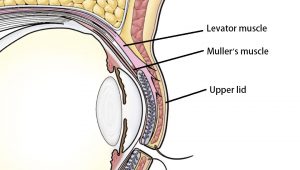- 2019/12/13
- Asymmetrical Eyes
What to do with asymmetrical eyes?
What to do with asymmetrical eyes?
There are many reasons for asymmetrical eyes, and the most common ones are as follows:
- Levator muscle weakness
Asymmetrical ptosis
3. Asymmetrical periocular tissues, innate one single eyelid and one double eyelid
To make differences between “levator muscle weakness” and “sagging skin,” we need to understand the mechanism of opening upper lids, chiefly by two muscles—the levator muscle and Muller’s muscle. When they contract, they can pull the upper eyelid
Levator muscle weakness will cause glassy eyes and difficulty in opening eyes. However, some droopy eyes are caused by outermost sagging skin with normal muscle function. Therefore, the target tissues for both surgical corrections are different—- skin or muscle. If it’s the problem of the levator muscle, only shortening the skin cannot fix asymmetrical eyes.
Asymmetrical periocular tissues, including innate one single eyelid and one double eyelid, can be carefully adjusted in the surgery, so it’s relatively less complicated.
Most patients expect to have not only natural but also symmetrical double eyelids. As to asymmetrical eyelid patients, in the fold planning and incision area of double eyelids, it’s not like drawing the same lines on both sides, but based on the details such as the functions of the levator muscle, eyelid sagging level, the fat under the eyelids, sunken eye sockets, it requires experience and more detailed measurement to achieve consistent aesthetics for both eyes after the surgery.







COMMENTS
In order top protect personal privacy,the message will be determined according to the situation.※is required field.
共0則留言